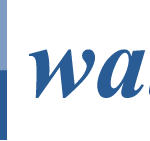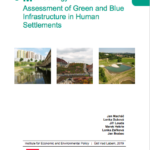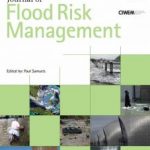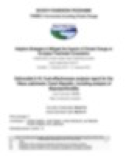

Using Bayesian Networks to Assess Effectiveness of Phosphorus Abatement Measures under the Water Framework Directive
Paper uses a concept of Bayesian networks to find out whether the selected measures are sufficient to achieve the “good status”
Abstract: The EU Water Framework Directive requires all water bodies within the EU member states to achieve a “good status”. Many economic assessments assume the “good status” is achieved using selected measures and evaluate only associated costs and benefits. In this paper, Bayesian networks are used to test this assumption by evaluating whether the “good status” can be achieved with the selected abatement measures. Unlike in deterministic analysis, Bayesian networks allow effectiveness of measures of the same type to vary, which adds credibility to the analysis by increasing its robustness. The approach was tested on Stanovice reservoir in Czechia using a set of 244 previously designed measures. The results show the target will be met with a probability of 72.4% using the most cost-efficient measures. Based on the results, improvements to the measure selection process are suggested.
Citation: Brabec, J., Macháč, J., Jílková, J., (2019) Water (Vol. 11, No. 9), doi: https://doi.org/10.3390/w11091791
Methodology for Economic Assessment of Green and Blue Infrastructure in Human Settlements
A method of monetary valuation and comparison of costs and benefits of green and blue infrastructure.
Green and blue infrastructure provides a variety of benefits in the form of ecosystem services for residents, workers and city visitors. At the same time green and blue infrastructure effectively deals with and prevents more and more frequent phenomena related to climate change such as intensive rainfall, drought or heat waves. Economic assessment is a tool that contributes to spreading knowledge about the benefits of green and blue infrastructure and at the same time represents an economic argument confirming its usefulness, which supports decisions about its implementation. For this purpose, the methodology for economic assessment of green and blue infrastructure in human settlements was developed by the IEEP team. The certified methodology includes a transparent procedure based on an analysis of costs and benefits of individual measures including examples of economic assessment in practice.
The certified methodology can be used at the government level or by local administrations as well as by interest groups and residents. Outputs of the methodology and valuations of green and blue infrastructure elements can be useful when planning new public areas (e.g., squares, parks, playgrounds, streets, etc.) or when deciding about utilization of areas and construction of specific elements (e.g., green roofs and walls, communal gardens, etc.).
Reference: Macháč, J., Dubová, L., Louda, J., Hekrle, M., Zaňková, L. et Brabec, J. (2019). Methodology for Economic Assessment of Green and Blue Infrastructure in Human Settlements. Ústí nad Labem: Institute for Economic and Environmental Policy (IEEP).
Download: ↓ Methodology for Economic Assessment of Green and Blue Infrastructure in Human Settlements (pdf.)
WATER IN THE CITY: Blue and Green Infrastructure Interdisciplinary
Development of interdisciplinary tools to support management of rainwater in municipalities.
Implementation of nature-based solutions in urbanized areas has a significant potential for adaptation of municipalities to climate change and reduction of associated negative effects such as floods from torrential rainfall, drought or heat islands. Although Czech municipalities try to prevent these effects, implementation of nature-based rainwater-retaining solutions in reality often faces insufficient capacities and lack of information necessary for their planning, procurement, implementation and promotion. One-sided solutions that do not fully exploit the potential for implementing blue and green infrastructure are often designed for these reasons.
The aim of our interdisciplinary project is to create a methodology that will clarify and facilitate municipalities’ decision-making during planning and implementation of nature-based rainwater-retaining solutions in urbanized areas. Furthermore, particular examples of possible solutions in an urbanized area will be provided, based on the character of the city and its surroundings.
The IEEP research team builds here on previous projects dealing with blue and green infrastructure. Existing outputs and tools will be further developed and applied in this project through interdisciplinary cooperation.
| Funding agency: | Technology Agency of the Czech Republic |
| Duration: | 05/2019 – 04/2021 |
| Contact person: | Jan Macháč, e-mail: machac@e-academia.eu |
| Researchers: | Jan Macháč, Marek Hekrle |
| In cooperation with: | University Centre for Energy Efficient Buildings of the Czech Technical University in Prague |
| Outputs: | The main output of the project will be a methodology for planning and implementation of nature-based rainwater-retaining solutions in urbanized areas and examples of possible solutions (expected release in April 2021) |
Mayors and “their” land: Revealing approaches to flood risk management in small municipalities
How Mayors of small municipalities perceive possibilities of municipal/local-based flood protection?
ABSTRACT: The multilevel adaptive governance of flood risk reduction has been emphasised in the last decades and supported by the requirements of European Flood Directive (EC, 2007), while assigning an increasingly important role to municipalities. By contrast, only fragmented efforts have addressed the personal (expert knowledge), financial, and institutional limits of municipalities to achieve the flood risk management (FRM) goals. Starting with thorough literature review, we emphasise the key gaps in current understanding of municipal FRM and note that scarce attention has been paid to small‐sized municipalities (both in area and population). Next, we present an empirical case study based on semi‐structured interviews with 17 mayors of small municipalities in a flood‐prone area of northern Czechia. The aggregation of the mayors’ opinions about flood threat and current and planned FRM measures as well as the perceived barriers in their implementation enabled the classification of different FRM strategies at a municipal level (herein referred to as “self‐confidence,” “fatalism,” and “active scepticism”). These strategies are then discussed in terms of the mayors’ leadership styles and the significant consequences on the effectiveness and efficiency of FRM at a municipal level.
Citation: Slavíková, L., Raška, P., Kopáček, M., (2018), doi: https://doi.org/10.1111/jfr3.12474
Cost-effectiveness analysis of the water quality improvement in the Orlik reservoir
Report of the REFRESH project on the economic analysis of the eutrophication problem solution in large Czech reservoir Orlik.
Continue reading
The IEEP won the new project funded by the Czech programme TACR-Zeta
From October 2017, the IEEP investigates methods for the economic evaluation of green and blue infrastructure in urban areas. Read more about the project here.
The IEEP organizes the public lecture of Prof. John Sheehan
 On Tuesday 7th November 2017, at FSE UJEP the Australian professor John Sheehan (University of Technology, Sydney) gave the public lecture called: Innovative Instruments of the Land Governance: Transferable Development Rights in Australia.
On Tuesday 7th November 2017, at FSE UJEP the Australian professor John Sheehan (University of Technology, Sydney) gave the public lecture called: Innovative Instruments of the Land Governance: Transferable Development Rights in Australia.
Info about our work spreads out in Usti Region
The IEEP work has been notices by the local “UJEP stories” portal (article only in Czech).





